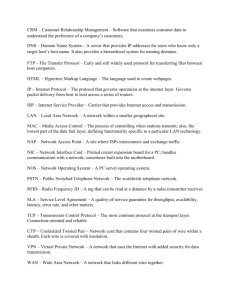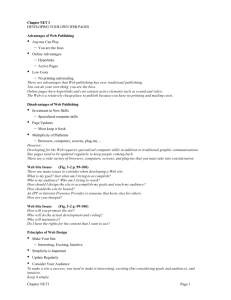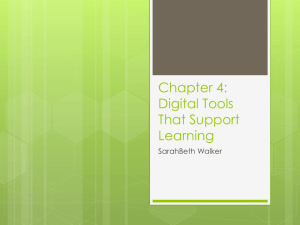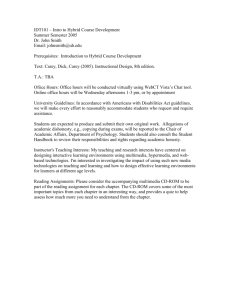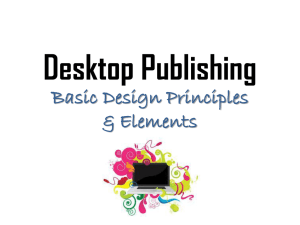Key Technology Trends
advertisement
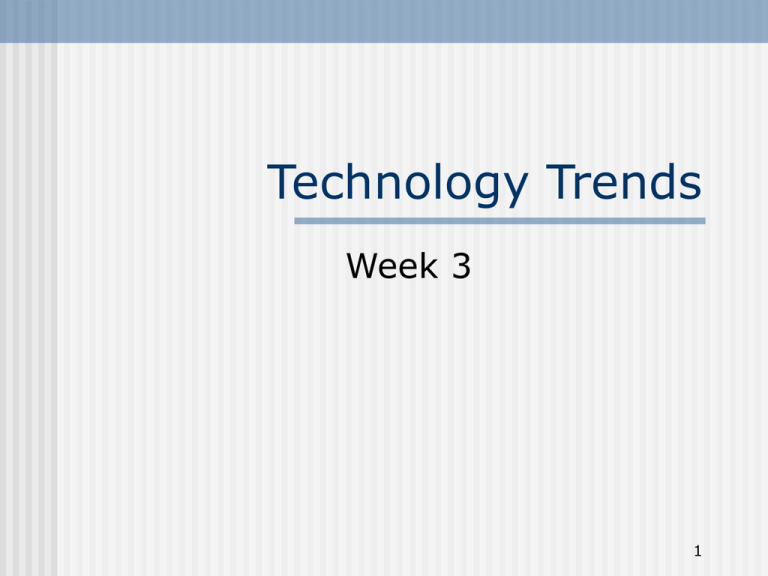
Technology Trends Week 3 1 Key Technology Developments We're going to look at how somewhat disjunct technology trends have shaped electronic publishing. Desktop Publishing Markup Systems Hypermedia & Multimedia (CD-ROM) Online Services Web 2 Making the Unreal into Reality “In early 1968 we made the rounds of The New York Times and Time/Life. And we found that our system was essentially too complex for them to understand. Remember that these people were producing magazines and newspapers and other forms of printed material. At most they had typographic programs that set type and maybe some software that did display ad management. … 3 But the idea of sitting on-line behind a tube and actually authoring and editing and rearranging and cross-referencing really was more than they were willing to believe you needed to do or should do. It was ‘very interesting.’ I remember this particular demo we did at Time/Life when our audience said, "That's great, but it will take us at least 10 years before people will be willing to sit down behind tubes and do anything on-line." • Andries van Dam, Hypertext Keynote 4 Desktop Publishing Macintosh Bit-mapped Display The Graphical User Interface (GUI) Laser Printers Page Description Languages (PostScript) Page Layout Programs 5 Apple, Adobe and Aldus Three companies shaped desktop publishing, which might have been more appropriately called desktop production. 6 Apple: 1984 Apple commercialized several new technologies in the Macintosh, which was released in 1984. Famous 1984 Commercial 7 LaserWriter The Apple LaserWriter, which was nearly as important as the Macintosh, was released in 1985. First ones cost $17,000. 8 Adobe Generates PostScript From “Inside the Publishing Revolution” Founded in 1982 by John Warnock and Charles Geschke, Xerox PARC researchers who had worked on laser printers and page description languages. 9 PostScript a device-independent page description language vector-based font descriptions an interpreted graphics programming language; the interpreter is embedded in the device. 10 WYSIWYG What You See is What You Get Aldus Pagemaker • Page layout • Later acquired by Adobe, Aldus retreated from its prominence – Quark Xpress came to be the leading professional page layout solution. Adobe’s InDesign so-called “Quark killer.” 11 Desktop Publishing Automates the process of publishing: editing, layout and typesetting of publications. Results in lower production costs. Reduces the time-to-market by eliminating steps in the production process. Enables any organization and any individual to create high quality publications. The Product is print; as a by-product, information exists electronically. 12 Markup Systems Batch Formatting Systems Troff TeX and LaTeX RTF Generalized Markup SGML XML 13 Batch Formatting Analogous to source code Formatter interprets source and creates output for a specific print device. Troff (typesetting) Nroff (screen-based) Example: Man Pages 14 SGML Standard Generalized Markup Language Came out of IBM (GML) and standardized by Charles Goldfarb. • Became an ISO standard in 1986 Really a language for defining markup languages. Assumes a batch processing model. 15 Structural Markup Use markup to identify the structural elements of a document; a tree structure. Separate presentation from content Allow the same content to reused in different contexts. Style sheets contain formatting instructions that are associated each element. Make it easier to exchange documents among different parties. 16 DTD Document Type Definitions A way to define a set of elements to be used in the markup of a class of documents and the hierarchical relationships among these elements. Assumed that communities/industries would standardizes on DTDs for interchange. 17 SGML Publishing Applications Met Needs of Defense Industry E.g. Aircraft Maintenance Manuals Fostered development of highly specialized, high-end "industrial" hypermedia software tools. Dynatext from EBT KMS (Knowledge Management Systems) Atex 18 Davenport Group Started in 1988, looked at domain of technical documentation, mostly for software. Docbook DTD emerged from this process. 19 Problems with SGML SGML tools were expensive and complex. Print formatting solutions were not practical. DTDs were difficult to develop. Primarily designed for text-based information. 20 Electronic Documents The battle over formats Markup • Identify semantics • Reuse • From SGML to XML Presentation • Page Fidelity • From Postscript to PDF 21 XML • An improved version of SGML developed at the W3C • Move beyond the browser Separate content from presentation Make possible multiple delivery methods Documents vs. Data Messaging formats 22 Hypermedia Systems Integration of text, graphics, and sound as objects or components of a document. Compound Documents These components can be linked together in a variety of ways. Focused on publishing information as a groupware application. 23 Intermedia Research Project at Brown University Timeline Begun as a project with Ted Nelson and Andries Van Dam in 1968; Nelson became “disillusioned” with it and left. First used for an English course in 1987 IRIS project, headed by Norman Meyrowitz Commercial release in 1989 Development ends around 1992. Outline View, Web View 24 Intermedia Windowing Model "hypermedia functionality should be handled at the system level, where linking would be available for all participating applications in much the same way that copying to and pasting from the clipboard facility is supported in the Macintosh and Microsoft Windows environments. ("IRIS Hypermedia Services" p. 38)" from Intermedia entry at the Electronic Labyrinth 25 Other Hypermedia Systems Owl's Guide Owl created first commercial hypertext system, released in 1986, as a productivity application. Implemented the idea of stretch-text. A kind of outliner for presentations. Four classes of links; cursor changes when moved over link. 26 HyperCard The most popular and practical implementation of hypermedia • Developed by Bill Atkinson at Apple. • Used a stack of cards as central metaphor • Organized images and text • Also supported sound, some animation and video • A million sold in first year (1987). • Purists debated whether it is truly hypertext. 27 Hypertext ’87 Keynote “HyperCard, despite all its limitations, is beautifully engineered, and has a wonderful user interface, especially for hypertext-style linking. It will really acculturate our computer user community. It is simple enough, despite its complexity, that a lot of people can get access to it at a relatively simple level. It's a fraction of what Doug and Ted and others of us believe to be the potential of hypertext or hypermedia.” Andries van Dam; Keynote. 28 HyperCard As Browser A single program used to access different kinds of content. Authoring and linking model was simple. Scriptable Hypertalk language was a precursor to Javascript. 29 CD-ROM A large capacity distribution medium in search of mixed-media content. Microsoft a big supporter, primarily viewing it as a means for software distribution. But also produced products like Cinemania. A packaged product that blurs the line between software and "content." 30 Macromedia Macromedia's Director became the highend authoring tool for CD-ROM development. A lot like HyperCard but more powerful and complex to learn. Lingo programming language like HyperTalk Head of Development at Macromedia is now Norman Meyerowitz 31 A Few Key Multimedia Applications Voyager Microsoft A Place For Art All in One Cinemania Corbis Beethoven Hard Day’s Night A Day in Thailand Broderbund Myst 32 Productivity applications Broderbund has not been successful with "information" or "content" on CD other than games. Doug Carlston, ex-CEO of Broderbund, described a productivity application as one where the user adds the value by contributing his or her own information. (Family Tree). 33 Broderbund 1997 Sales of $190M % of total Productivity 56 Education 27 Entertainment 13 Affiliated labels 4 Total 100 Sold to Learning Company for $420 in 1998. “Broderbund's first big hit came in 1984 with Print Shop. The next year it released Where in the World Is Carmen Sandiego? The company went public in 1991, and the following year it acquired PC Globe, an electronic atlas publisher. Broderbund also expanded its list of affiliated labels (software it distributes exclusively for other publishers) and in 1994 formed a joint venture with Random House to create Living Books, a line of interactive children's storybook CD-ROMs.” Source: Hoover’s. 34 CD-ROM Issues Convergence of imaging, animation, audio and video technologies, while ongoing difficulty in standards and interoperability. Content unavailable outside of proprietary program; programs dedicated to one body of content. Biggest success in games and educational software. 35 Additional CD-ROM Issues High production costs for consumer products. • Projects began to look more like "Hollywood" movie projects and did not meet with success. (1218 months of effort; $5-10 million budget.) Difficulty of developing distribution channels • bookstores were not successful selling CD-ROMs. • software stores also had difficulty Continued use for data distribution. 36 Online Services Two ends of the spectrum. Consumer Professional 37 Consumer Online Services CompuServe (founded 1969) AOL (1985) Prodigy, MSN Dial up access User-created content & community Bulletin-boards/Conferencing/Forums Email, Chat 38 Professional Online Services Mead-Data Lexis-Nexis Required specially trained experts to perform searches Research oriented and publication focused. 39 Early Internet Systems Ftp Gopher University of Minnesota Menu-based access to text files Wais Wide-Area Information System Search engine by Brewster Kahle 40 The Web Tim Berners-Lee at CERN invents the Web as a global hypertext system utilizing the Internet. Submits paper to HyperText Conference in 1991; it’s rejected. NCSA begins Mosaic development in 1993. 41 Simple Standards HTTP, HTML, and URLs A simple protocol, a simple deviceindependent data format and a straightforward global addressing system. 42 HTML The data now exists outside of the browser software required to access and display it; allows other programs besides browsers to access it. 43 URL -- Uniform Resource Locators. Tim Berners-Lee key insight was that a distributed hypertext system did not have to know in advance whether a link reference could be resolved. 44 Reshaping Distribution The Web’s most significant contribution is establishing ubiquitous point-to-point distribution. E-commerce: The Web became its own channel. Relatively low cost for development. Wide range of applications beyond publishing. 45 New Directions Streaming Media Rich Media (Flash) Peer To Peer Napster et. al • Clients become servers. Web Services Automating the exchange of information among web applications. • Servers talk to servers. 46 Conclusions Disjunct Developments The development of desktop publishing, CDROM and the Web seem to be separate paths. The people and the companies that shaped these developments were starting off in new directions, deciding that what was essential involved ignoring much of what was there. Also, those companies heavily invested in one remained skeptical that "the next thing" was real. 47 Desktop publishing requires a fine degree of control over presentation; so did CDROM. Hypermedia on CD-ROM introduced basic forms of interactivity. The Web began with more basic forms of content, presentation and interactivity. 48 A CD-ROM was a packaged good. Lacked an established distribution channel. Web content is not really packaged. Online service model Advertising 49 Collaborative Development Web development benefited from people who had experience in desktop publishing, markup systems, hypermedia, and CD-ROM authoring. Confluence of creative and technical capabilities. 50
